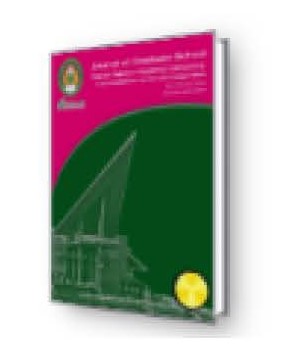การพัฒนาทักษะกระบวนการทางคณิตศาสตร์ ผลสัมฤทธิ์ ทางการเรียนและความพึงพอใจต่อการเรียนโดยวิธีสอนแบบ โครงงานร่วมกับการจัดการเรียนรู้แบบ 4 MAT ของนักเรียน ชั้นประถมศึกษาปีที่ 4
บทคัดย่อ
บทคัดย่อ
การวิจัยครั้งนี้เป็นการวิจัยเชิงทดลอง มีความมุ่งหมาย เพื่อพัฒนาและศึกษาผลการจัดการเรียนรู้โดยวิธีสอนแบบโครงงานร่วมกับการจัดการเรียนรู้แบบ 4 MAT ที่ส่งต่อการพัฒนาทักษะกระบวนการทางคณิตศาสตร์ ผลสัมฤทธิ์ทางการเรียนและความพึงพอใจต่อการเรียนของนักเรียนชั้นประถมศึกษาปีที่ 4 กลุ่มตัวอย่างที่ใช้ในการวิจัยครั้งนี้ เป็นนักเรียนชั้นประถมศึกษาปีที่ 4 โรงเรียนบ้านยางโล้นเจริญราษฎร์ไพบูลย์ ศูนย์อำนวยการเครือข่ายภูผายล ภาคเรียนที่ 2
ปีการศึกษา 2556 จำนวน 27 คน ซึ่งได้มาจากการสุ่มแบบแบ่งกลุ่ม เครื่องมือที่ใช้ในการวิจัยประกอบด้วย 1) แผนการจัดการเรียนรู้โดยวิธีสอนแบบโครงงานร่วมกับการจัดการเรียนรู้แบบ 4 MAT 2) แบบวัดทักษะกระบวนการทางคณิตศาสตร์ 3) แบบประเมินทักษะกระบวนการจากโครงงาน 4) แบบทดสอบวัดผลสัมฤทธิ์ทางการเรียน 5) แบบสอบถามความพึงพอใจต่อการเรียน สถิติที่ใช้ในการวิเคราะห์ข้อมูล ได้แก่ ค่าเฉลี่ย ส่วนเบี่ยงเบนมาตรฐาน ค่าดัชนีประสิทธิผล สถิติทดสอบค่าที (t-test for Dependent Samples และ t-test for One Samples) การวิเคราะห์ความแปรปรวนร่วมพหุคูณแบบทางเดียว
การวิเคราะห์ความแปรปรวนร่วมแบบทางเดียว และ การวิเคราะห์ความแปรปรวนแบบทางเดียว
ผลการวิจัยพบว่า
1. แผนการจัดการเรียนรู้โดยวิธีสอนแบบโครงงานร่วมกับการเรียนรู้ แบบ 4 MAT ของนักเรียนชั้นประถมศึกษาปีที่ 4 มีประสิทธิภาพเท่ากับ78.82/75.93 และดัชนีประสิทธิผลของการเรียนรู้ มีค่าเท่ากับ 0.6770
2. ทักษะกระบวนการทางคณิตศาสตร์ของนักเรียนชั้นประถมศึกษาปีที่ 4 หลังเรียนสูงกว่าก่อนเรียน อย่างมีนัยสำคัญที่ระดับ .05
3. ทักษะกระบวนการทางคณิตศาสตร์จากโครงงานคณิตศาสตร์ของนักเรียนชั้นประถมศึกษาปีที่ 4 โดยภาพรวมอยู่ในระดับสูง อย่างมีนัยสำคัญที่ระดับ.05 เรียงตามลำดับคือ ความสามารถในการแก้ปัญหา ความสามารถในการให้เหตุผล ความสามารถในการสื่อสาร การสื่อความหมายและการนำเสนอ ความสามารถในการเชื่อมโยงความรู้ต่างๆ ทางคณิตศาสตร์และเชื่อมโยงความรู้อื่น และ ความคิดริเริ่มสร้างสรรค์4. ผลสัมฤทธิ์ทางการเรียนของนักเรียนชั้นประถมศึกษาปีที่ 4 หลังเรียนสูงกว่าก่อนเรียน อย่างมีนัยสำคัญทางสถิติที่ระดับ .05
5. ความพึงพอใจต่อการเรียนของนักเรียนชั้นประถมศึกษาปีที่ 4 โดยภาพรวมอยู่ในระดับมาก อย่างมีนัยสำคัญทางสถิติที่ระดับ .05
6. ทักษะกระบวนการทางคณิตศาสตร์และผลสัมฤทธิ์ทางการเรียนของนักเรียนที่มีความสามารถทางการเรียนต่างกัน หลังเรียน มีความแตกต่างกันอย่างมีนัยสำคัญทางสถิติที่ระดับ .05 และเมื่อผู้วิจัยทำการวิเคราะห์ความแปรปรวนร่วมแบบทางเดียวด้วยสถิติ One-way ANCOVA แล้วจึงทำการวิเคราะห์ภายหลัง (Post Hoc) ด้วยสถิติ Bonferoni แล้วพบว่ามีความแตกต่างกันอย่างมีนัยสำคัญทางสถิติที่ระดับ .05 ผลการวิเคราะห์ดังกล่าว มีดังนี้
6.1 นักเรียนที่มีความสามารถทางการเรียนสูง มีทักษะกระบวนการทางคณิตศาสตร์สูงกว่านักเรียนที่มีความสามารถทางการเรียนปานกลางและต่ำ และนักเรียนที่มีความสามารถทางการเรียนปานกลาง มีทักษะกระบวนการทางคณิตศาสตร์สูงกว่านักเรียนที่มีความสามารถทางการเรียนต่ำ อย่างมีนัยสำคัญทางสถิติที่ระดับ .05
6.2 นักเรียนที่มีความสามารถทางการเรียนสูง มีผลสัมฤทธิ์ทางการเรียนสูงกว่านักเรียนที่มีความสามารถทางการเรียนปานกลางและต่ำ และนักเรียนที่มีความสามารถทางการเรียนปานกลาง มีผลสัมฤทธิ์ทางการเรียนสูงกว่านักเรียนที่มีความสามารถทางการเรียนต่ำ อย่างมีนัยสำคัญทางสถิติที่ระดับ .05
6.3 นักเรียนที่มีความสามารถทางการเรียนต่างกัน หลังเรียนโดยวิธีสอนแบบโครงงานร่วมกับการจัดการเรียนรู้แบบ 4 MAT มีความพึงพอใจต่อการเรียนไม่แตกต่างกันอย่างมีนัยสำคัญทางสถิติที่ระดับ.05
ABSTRACT
The purposes of this experimental research were to 1) develop the lesson plans in Learning by project method in conjunction with the 4 Mat model of Prathomsuksa 4 students process to abtain the efficiency as the criterion set of 70/70 and Find out the effectiveness of lesson plans by Project method in conjunction with the 4 Mat model of Prathomsuksa 4 students the abtain standard criteria at the 50 percent up , 2) compare the mathematic process skill before and after learning by Project method in conjunction with the 4 MAT model of Prathomsuksa 4 students, 3) Compare the mathematic process skill from Project of Prathomsuksa 4 students learning by project method in conjunction with the 4 Mat model with the criteria set 4) Compare learning achievement before and after learning by Project method in conjunction with the 4 MAT model of Prathomsuksa 4 students, 5) Compare learning satisfaction of the students of Prathomsuka 4 student learning by project method in conjunction with the 4 Mat model with the criteria set. 6) Compare the mathematic process skill, learning achievements learning satisfaction of the students with high, moderate and low learning abilities after learning by Project method in conjunction with the 4 Mat model of Prathomsuka 4 student. The samples consisted of 27 students in Prathomsuksa 4 in the second semester of 2013 academic year at Banyanglonjareanratpibun School using random cluster sampling technique. The research instruments were composed of: 1) the lesson plans based on the Project method in conjunction with the 4 Mat model, 2) mathematics process skill test, 3) mathematics process skills evaluation from project 4) a test of learning achievements, and 5) a questionnaire of learning satisfaction. The data were statistically analyzed using percentage, mean, standard deviation, Effectiveness Index (Effectiveness Index: E.I.), t-test (Dependent Samples), t-test (One Samples), One-way MANCOVA, One-way ANCOVA and One-way ANOVA.
The findings of this study were as follows :
1. The efficiency the lesson plans in the learning Substance of Science the Project method in conjunction with the 4 Mat model of Prathomsuksa 4 students was at 78.82/75.93 and The efficiency the lesson plans in the learning Substance of Science using the Project method in conjunction with the 4 Mat model of Prathomsuksa 4 students was 0.6770
2. The mathematic process skill of Prathomsuksa 4 students higher than before learning at the .05 level of significance.
3. The mathematic process skill from Mathematic Project of Prathomsuksa 4 students were at a high level at the .05 level of significance on the aspect of the problem solving, the reasoning, communications and presentations, the connection, and creativity.
4. The learning achievements of Prathomsuksa 4 students after learning were higher than before learning at the .05 level of significance.
5. The student satisfaction toward is show at high level at the .05 level of significance.
6. The students in Prathomsuksa 4 with different learning after being cooperative gained mathematic process skill, learning achievements, and learning satisfaction with significant difference at the .05 level. In addition, One-way Analysis of Variance (One - way ANOVA) showed that:
6.1 The students with different learning were mathematic process skill, after being taught, at the .05 level of significance. The students with high learning abilities gained higher mathematic process skill than those with moderate and low learning abilities. The mathematic process skill among the students with moderate and low learning abilities showed no significant differences.
6.2 The students with different learning gained their learning achievements at the .05 level of significance. The students with high learning abilities
6.3 There was a significant difference toward learning satisfaction among the students with different learning abilities at the .05 level.ดาวน์โหลด
รูปแบบการอ้างอิง
ฉบับ
ประเภทบทความ
สัญญาอนุญาต
บทความทุกบทความที่ตีพิมพ์ในวารสารบัณฑิตศึกษา มหาวิทยาลัยราชภัฏสกลนคร ถือว่าเป็นลิขสิทธิ์ของบัณฑิตวิทยาลัย มหาวิทยาลัยราชภัฏสกลนคร





